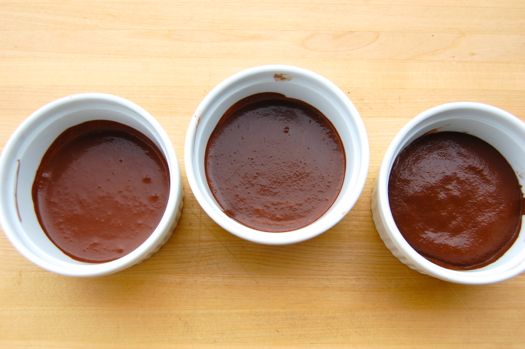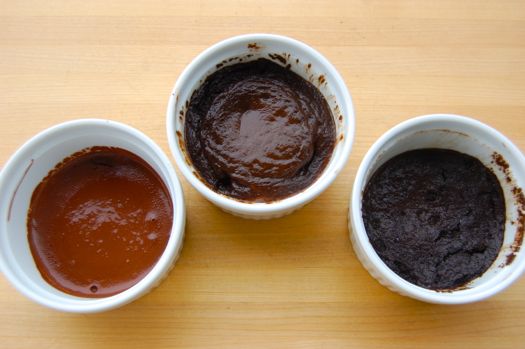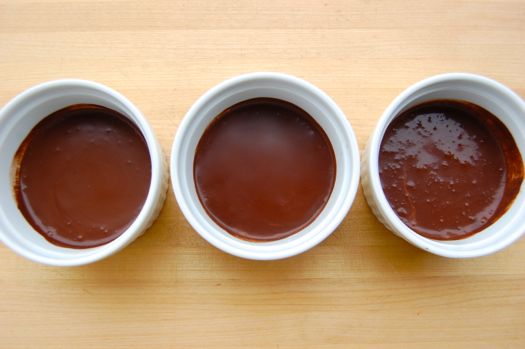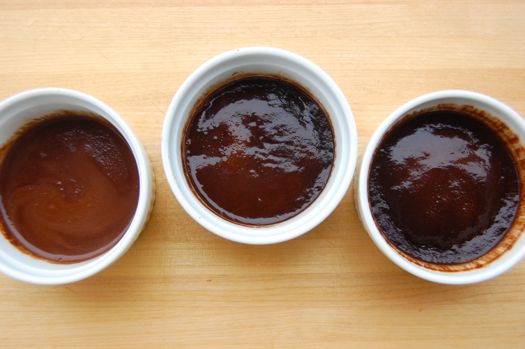The Myth of the Red Chocolate Cake II
I’ve received a little flak this past week from readers who didn’t think my red chocolate myth busting post from last Tuesday was rigorous enough. “No Dutched chocolate!” “You didn’t heat it!”
So OK then. Here goes. First we have a slurry of un-Dutched Ghiradelli cocoa powder and water. Left to right, with a teaspoon of tartaric acid, a teaspoon of baking soda and a combination of both (but only half a teaspoon of each because I didn’t want it exploding all over the place like last time).
Nothing is happening with the acid, we’ve got a little reaction going with the soda (un-Dutched cocoa is slightly acidic, remember) and a nice reaction going with both, as you’d expect. Are any of them even a little red, however? No.

Here they are after they’ve been brought to near boiling, after 45 seconds in the microwave. Very interesting. And very not red.

Now the same with some Dutched Droste cocoa powder. Nothing going on the left with the acid, also nothing going in the middle with the soda (Dutched cocoa is not acidic, it’s a large part of the point of Dutching) and a reaction starting with the combo. Other than the fact that this cocoa wasn’t as dark as I expected compared to the un-Dutched, there’s nothing surprising here. No redness.

Here they are after the same 45-second shot in the microwave. Not red. Not red. And definitely not red.

So I think we’ve fairly definitively dispelled a myth here, and there shall be no more experiments as Mrs. Pastry is already upset enough about the waste of expensive cocoa. If you have a counter-experiment to disprove me, by all means send pictures!
Interesting mythbuster post. I too, lament the waste of cocoa powder but it seems to have gone to strong cause! Hahaha.
-Sally from Jama Cocoa
Ha! Thanks Sally! Anything for science!
– Joe
Okay, now explain why the cocoa pots looked more “cooked” from left to right. 🙂
Especially the un-Dutched cocoa. The tartaric acid looks nearly the same, the baking soda looks like pudding and the combo looks like a brownie (mmm…brownies)
Hey Ursula!
It’s the soda. Alkalinity encourages browning reactions. It’s why bagels and pretzels are boiled with soda or lye…so that crusts get crispy and nut-brown in the oven. So that’s what happening there. As for why the right-most samples are the darkest after heat, I’m not completely sure. It might have something to do with more bubbles and more surface area…perhaps the CO2 comes into play…something to cause more browning reactions. I’ll have to think on that one. A great question!
– Joe
Also, by adding soda, you must be sort of “Dutching” the cocoa – or increasing the Dutchedness – thereby making it darker anyway.
I think that’s likely. Thanks, Bronwyn!
– Joe
That’s science, baby.
Great post, J
Chris
Thanks for this…I never knew!
Thanks to you, HBM!
– Joe
This might be a good opportunity for people to think about hitting the Tip Jar so the science can continue unabated. ;>
Oh that would please the missus. Would it ever! 😉
Thanks, Rainey!
– Joe
I think your last line is the most important. It would be impossible to prove the red color DIDN’T come from the chocolate because someone will always be able to say you missed something. If someone says the red does come from the chocolate have them post pictures & a recipe so we can try it ourselves.
What could be better? Science AND chocolate cake!
And I’m the first to admit I ain’t no chemist! 😉
I’m a guy with some cocoa and a microwave.
Thanks, Frankly!
– Joe
You learn something new everyday! Thanks for the heads up.
My pleasure, Spenser!
– Joe
And that’s exactly why I love reading your blog!
Thanks, Shweta!
– Joe
While not fire-engine red, the un-Dutched Ghiradelli does appear auburn to me, which I suspect was the origin of the whole “red chocolate cake” story to begin with. Auburn hair is often called “reddish” without being RED red 😉
Not to be contrary; I just like justifying a food tradition…
Hehe…you may hold whatever opinion you wish, Gloria! I’m just sayin’…if someone came up off the street and held this out to you and said “what color is this?”…what would you say?
Would you look for shades of red in it if it weren’t chocolate? Me thinks…not. 😉
Cheers and thanks for the comment!
– Joe
Currently doing my own experimental series on those 😉
Found your page through the red – colour thing. And I must say, did you REALLY really expect a supernova bloody red? We are NOT talking eye-cancer food colours here 😉
What I DO find is that the hue or tinge of the brown is reddish, rather than let’s say black, core brown or green brown, blue brown or such things. You can see differences in the hues between your pots definitely. Also, you only mixed acids and lye, not within the mixture of the cake. I know that basic ingredients e.g. turn wheat yellow (as in egg noodles, which originally are not actually with egg, but a lye water). This may add to the colour outcome. So the myth is destabilized, but not busted just yet – you gotta bake a cake for that *lol
Which is what I have done. I found a pretty red tinge, reminding me of the red which morello cherries add to black forest cake (not the cherries itself, but the impression of the cherries close to the chocolat sponge layers). In that context I was wondering how closely related red velvet and black forest cake actually are. Ah – I’m deviating.
I yet have to repeat the experiment, since I swear, but am not entirely sure any more, that I did not mix them cupcakes up. The thing that puzzles me is that the ones with beetroot powder are LESS red, than the ones without. Once I’ve got that settled, I’ll post more on what I’ve got on it. Cheers for your trials though! Always good to see others trying as well!
Hey Eliana!
Like that comment! Hehe…no I wasn’t expecting a primary color, just something that could reasonably be described as red-brown to the average person (not a graphic designer or colorist who can detect a hint of red in navy blue). I certainly don’t dispute that some cocoa powders have reddish hues in their palettes. The myth here in the States however is that the addition of acid and/or heat shifts the overall color of cocoa toward the red — and I think I’ve fairly well shown that isn’t the case.
But I’m open to being disproved. Definitely keep me up-to-date on your experiments, and if you can give me a process and a formula (based on readily available ingredients) that will turn cocoa powder reddish here in my own kitchen I will consider myself chastened! 😉
Nice to meet you, good luck with the new blog and please keep in touch! Cheers,
– Joe
I understand with the colour *lol. That was my expectation as well. Just a reddish-hue. I mean – I know what anthocyanins look like. Basically the colour of autmn leaves in red, or very young leaves e.g. of roses on the tips. It is a bright red, but the cacao will still be brown, so they will compete for being noticed.
Just posted my results on my blog from the day before. So far, I HAVE gotten some reddish hue (which really doesn’t come out on the pictures much, but it’s visible – I asked my housemate, just to make sure). The interesting thing is, that the colour does only come up in the inner parts, not on the crust part, which is just a plain, horse like brown. Nice, but not red at all.
The only thing I am a bit worried about is, HAVE I MAYBE MIXED UP THE TEST CUPCAKES. (There were some with beetroot powder). So I gotta do it again *lol Have done that in the lab before. I was tired when I took them out of the pan, so just am not sure enough. Either way, my aim is to make THE Red Velvet Cake, so I gotta work on the icing, colour, texture and taste again anyway – plenty of time for more experiments, also with different chocolate concentrations! (BTW – you should be able to get the ingredients, maybe not beetroot powder, but I’m still working on the recipe *lol)
Like your blog btw! Came across it some time ago I think – interesting stuff!
Cheers Eliana
Keep up the good work, Eliana, and get back to me with the results!
Cheers and thanks!
– Joe